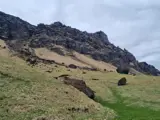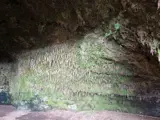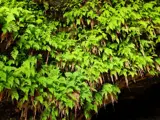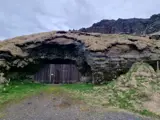An outstanding feature of the cave are the ferns that grow on the ceiling
Steinahellir
Steinahellir is a cave 36 km from Hvolsvöllur under Eyjafjall just off the National Road #1 by the Bay of Holtsós. It is thought to be a natural cave that was later enlarged by man to make it more habitable. An outstanding feature of the cave are the ferns that grow on the ceiling.
In 1858, the farmers under Eyjafjöll rebelled against the Sheriff of Ránga, who had made a rule that all sheep would need to be washed to combat the highly contagious psoroptes-ovis, (a type of mange that infects cattle and sheep.) The farmers disagreed and taking whips, nearly managed to drive the sheriff into the Hellisvatn pool, where they wanted to drown him. His deputy sheriff was so fearful that he revoked the ruling and thereby saved the sheriff from this punishment. The sheriff and his deputy rode away, humiliated, and the farmers mounted their horses gleefully, riding home to tell everyone of their victory. There are also many stories of elves and hidden people both in and around this cave.
For centuries Steinahellir cave was used by the farmers at Steinar farm to house sheep. In 1818 the cave became the area's parliamentary assembly site and remained so until 1905. According to Matthías Þórðarson, former National Cultural Heritage Manager, ships were at one point built at Steinahellir.
The cave is believed to be a naturally occurring feature in the palagonite cliff, but was manually deepened and broadened over time. There are many stories of supernatural happenings and enchantments connected with Steinahellir cave.
Ghosts and spirits have been seen in and around the cave for centuries; the most famous is the tale of the 14 sailors who died when their ship stranded at Fjallasandur beach. The following winter the ship was moved over the ice, from Fjallasandur, via Holtsós estuary to Steinahellir. One day Þorgils from Rauðnefsstaðir farm was riding by and exchanged some words with a man he met by the cave. He then looked up and saw 13 'horrible men' standing on the ship. Þorgils realised that this was the dead crew from the wrecked ship and rode away in haste.
One tale warns not to pick the enchanted ferns which grow in the cave as bad luck will befall anyone who does. A farmer from Steinar once picked a fern from the cave and soon afterwards one of his cows, which was grazing in the area, fell down from the top of the cave-mouth and died. Another tale tells of a traveller who picked a fern without knowing about the enchantment, and a few years later he lost his health. Until his death he blamed his misfortune on the accidental picking of the fern in Steinahellir.
The farmer Jón Jónsson was passing Steinahellir in 1870 when it was pitch dark. Suddenly a ghost appeared and blocked his way. Jón pulled out a pocket knife and made the blade turn backwards since ghosts turn everything around. By this the ghost yielded and Jón could continue his journey.
Steinahellir cave was listed as a protected archaeological site in 1975 and is under the management of the Cultural Heritage Agency of Iceland which had the wooden panel in the cave-mouth rebuilt in the fall of 2015.
Source: Website of the Cultural Heritage Agency of Iceland. Date: 6. September 2019
Celebrating Earth Heritage
How to visit the Katla Geopark
Katla UNESCO Global Geopark is in central South Iceland



